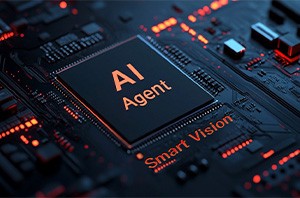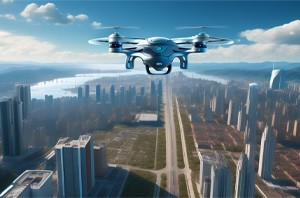Recently, Julian Birkinshaw, Deputy Dean and Professor of Strategy and Entrepreneurship at London Business School, together with Dickie Liang-Hong Ke, Director of Executive Education Programs and Visiting Professor at London Business School, have co-authored a case study based on an in-depth study of Digital China's digital transformation journey titled "The Transformation of Digital China: Harnessing the Potential of Data, Cloud, and AI."
This case has been showcased in Professor Birkinshaw's popular course, receiving enthusiastic feedback. Mr. Guo Wei, Chairman of Digital China, and his team were invited to visit London Business School to provide an in-depth introduction to the company’s transformation process and answer questions from students.

Julian Birkinshaw
Deputy Dean of London Business School
"As a global business school, we are constantly looking for excellent cases worldwide. That Digital China is chosen, not only because of its importance and notability in China, but also because of its deep application in digital technology. Its development keeps pace with the times, helping future business elites around the world better understand the modern business environment. The story of Digital China also reflects Mr. Guo Wei's philosophy—digitization is not just a process, but the fundamental reason for a company's existence. This is why we chose Digital China as a case study."

Dickie Liang-Hong Ke
Executive Education Program Director and Visiting Professor
"Digital China's strategy of integrating data with the cloud caught our attention. Everyone talks about digital transformation, each with their own interpretations and confusions. I think Digital China might be the first company to put digital transformation into a strategic framework with its own theories. The framework includes not only strategies, but also implementation methods, which have already been promoted within the company. This is not just a Chinese case; it’s a strategic transformation of an IT company primarily engaged in B2B business. Digital China's transformation is not just one instance of change, but a series of successful transformations."
Further exploration of this case has been written into an insightful article titled "The Next Era of Digital Change," published in London Business School's "THINK" thought leadership magazine.
We have specially translated this article, hoping more readers can delve into its insights.
The Next Era of Digital Change
What changes will the significant advancements in artificial intelligence technology bring to the business world? Over the past year and a half, generative AI has been at the center of our focus. The main interest lies in how AI can help knowledge workers improve efficiency and effectiveness. For the multitude of changes emerging, this is just the tip of the iceberg, with more changes occurring mainly out of sight, in how enterprises utilize AI to stand out in competitions.
From a long-term perspective, AI is merely the latest chapter in the story of digital innovation, with each chapter continuously opening new ways of working for businesses. The 1970s were dominated by large computers managed centrally by big corporations; the 1980s saw the era of personal computers, democratizing access to computing; the 1990s marked the beginning of the networked computer era, greatly enhancing information sharing across society; the early 21st century introduced cloud computing, from which today's large platform companies emerged.
What kind of innovative business strategies and work methods will the age of AI bring? The answer remains uncertain. It is reported that some leading tech companies are already exploring the potential of AI to develop new products and services. Most of them are familiar faces such as Microsoft, Google, Amazon, Facebook, and Elon Musk.
However, these West Coast giants do not monopolize digital innovation. Sometimes, we need to look further to objectively see the potential direction of the business world.
In this article, we share insights gained from the digital transformation process of Digital China and some insights from Mr. Guo Wei, Chairman of Digital China. Most Western readers are more familiar with China's B2C digital giants like Alibaba, Tencent, and ByteDance (the parent company of TikTok). Unlike these, Digital China does not sell any products directly to consumers; it offers digital services similar to those provided by companies like Accenture, Infosys, or CapGemini.
More than twenty years ago, Digital China separated from Lenovo, a computer manufacturer today, and has now become a leading digital services company in China, selling complete sets of hardware, software, and solutions to large banks, corporate clients, consumer goods companies, and retailers. In terms of scale, Digital China now has about 20,000 employees and revenues of $20 billion.

Julian Birkinshaw (center), Deputy Dean and Professor of Strategy and Entrepreneurship at London Business School;
Mr. Guo Wei (left), Chairman of Digital China;
Dickie Liang-Hong Ke (right), Executive Education Program Director and Visiting Professor at London Business School, CEO of NetAdd Technology.
Mr. Guo Wei, a legendary figure in China's IT industry, has led Digital China for over 20 years and has published several best-selling books, including "The Power of Digitalization" and "The Power of Time." He has also been named on the Fortune China list of top 50 business leaders. We recently turned the story of Digital China into a teaching case study incorporated into the curriculum at London Business School. In this process, Mr. Guo shared some of the innovations that Digital China has undertaken in collaboration with Chinese enterprises, as well as his views on the new round of transformations brought about by artificial intelligence.
Mr. Guo first distinguished between informatization and datafication. The former merely uses information in a structured way to complete tasks faster and more reliably, aiming to improve corporate efficiency; while the latter is more strategic, focusing on reshaping the concept of a company, which can be seen as a set of digital assets. These assets include codified traditional data, unstructured scattered data, and technical know-how.
Therefore, datafication needs to be modular. We need to clearly define these digital assets so that they can be configured and reorganized in new ways to create value. The best way to achieve this is by uploading data to the "cloud", placing it on a platform that transcends specific locations or businesses, which Mr. Guo calls "integration of data and cloud."
Of course, this is not a new concept. The enormous success of Amazon Web Services (AWS) is largely due to their early investments in cloud services for small and medium-sized enterprises. But in China, many companies are vigorously promoting the integration of data and cloud. WeChat is a model of integrated services built according to digital native principles. One reason for its success is its ability to seamlessly integrate services from thousands of different independent businesses into a single convenient and user-friendly interface.
Digital China is also actively developing cloud services and the innovative infrastructure required for cloud service operations. From 2018 to 2022, Digital China's sales in related fields have grown by a full sevenfold.
Another key pillar in Mr. Guo Wei's digital worldview is the "middle platform," which refers to a set of centralized integration systems that lie between the organizational back-end and the customer-oriented front-end of Digital China. The concept of the middle platform was first introduced to China by Alibaba in 2015, and Mr. Guo has adopted it as a guiding approach for the company's operations. In his words, the middle platform can link large amounts of data from multiple sources, aiding in understanding the data, allowing different applications and tools to communicate, to ensure smooth data transfer from one place to another. The aforementioned datafication work, or the process of encoding digital assets and transforming them into business innovations, mostly occurs within the middle platform.
Next is artificial intelligence, especially "Artificial Intelligence Generated Content" mentioned by Mr. Guo. Over the past few years, Digital China has been using AI to help the company compile and organize various documents such as reports, customer feedback, and internal files, digesting massive amounts of unstructured data. He cited an appliance company as an example, which built an AI model to integrate proprietary information across all its business lines. This allows employees to refer to the results given by the model and make faster, more informed decisions. Digital China's AI product is named "Smart Vision," aimed at "cultivating user capabilities to build future business scenarios and conceive new ideas."
Looking at the achievements of Digital China over the years, from launching the "Digital China Business Bridge" service in 2006 (sharing information with suppliers), to cloud computing and innovative infrastructure (Digital China's own computing, storage, and networking products), to AI products, its consistent approach has been to liberate information (following the path of datafication) to facilitate more effective use of information within and between organizations. Mr. Guo repeatedly mentions the term "Boundarylessness," a concept that first became popular in the 1990s. Thanks to digital innovation, the era of "Boundarylessness" has finally arrived.
Returning to our initial question, what new ways of working will the age of artificial intelligence bring? We are not sure yet, but the changes discussed by Mr. Guo suggest that as data becomes more modular and easier to access than ever before, the way companies operate should become more smooth and flexible. New ways of working should also place greater emphasis on insight and judgment, as even the smartest AI seems unable to replace these human qualities. This means that small businesses will emerge in large numbers and coexist with large corporations, forming a system similar to an ecosystem.
Finally, here are some reflections we share with our students on the case study of Digital China:
● The digital revolution never ends
Each wave of digital innovation brings new tools and technologies, triggering further changes that alter the way companies operate and the ways in which they create and capture value. Therefore, the most successful companies are those that remain vigilant and ready to recalibrate their use of digital technologies at any moment. If you are still stuck using traditional IT systems, you need to break away from the status quo and seek innovation promptly, or you will be left far behind by new competitors.
● Digital innovation is not exclusive to the West Coast of the United States
There is an interesting competitive dynamic among Chinese companies: they place a high value on growth, have a significant demand for data, and are very afraid of missing opportunities. They do not suffer from the problem of clinging to traditional IT systems as severely as Western companies. As a result, many interesting digital innovations have emerged in China, both in services and applications. This has been briefly touched upon in the services provided by Digital China mentioned earlier, and other innovations are also evident, such as WeChat, TikTok, and Shein.
● Do not discard human involvement
Some observers predict that the irresistible rise of artificial intelligence will lead to a gloomy future for people's work, envisioning jobs filled with automated processes and algorithm-driven decisions. Our view aligns more closely with Mr. Guo Wei, who says that the purpose of digital intelligence is to "maximize human creativity and value." Today's business leaders have a moral obligation to make full use of technology to bring greater fulfillment to their employees' work. In the words of John Naisbitt, one of the earliest futurists: "Whenever a society introduces a new technology, there will inevitably be a human response that counterbalances it—requiring a high degree of human involvement; otherwise, the technology will be rejected. We must learn to balance the material miracles brought by technology with humanity's inherent spiritual needs."
 Smart Vision
Smart Vision Shenzhou Kuntai & Smart Vision Integrated GenAI Suite
Shenzhou Kuntai & Smart Vision Integrated GenAI Suite Data Asset Accounting
Data Asset Accounting Data Security Control Platform
Data Security Control Platform Shenzhou Yanyun Integrated Solutions
Shenzhou Yanyun Integrated Solutions Cloud Management Services
Cloud Management Services AI Computing Power Servers
AI Computing Power Servers Storage Products
Storage Products Low-Altitude Solution
Low-Altitude Solution RaaS Operation Service Solution
RaaS Operation Service Solution





